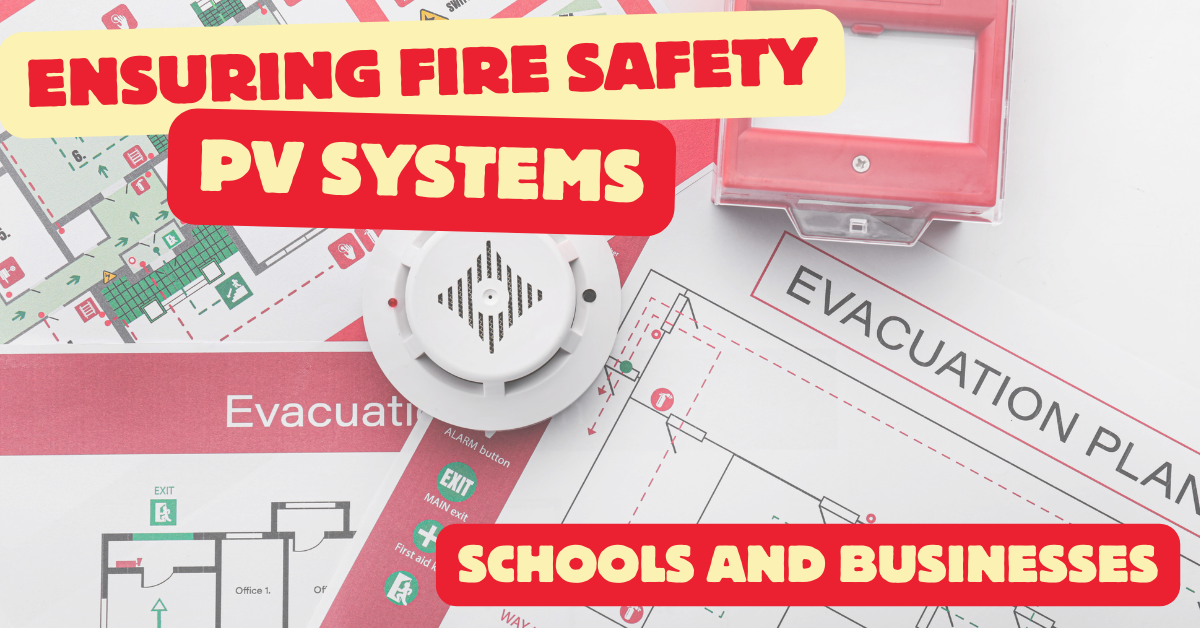Ensuring Fire Safety Awareness in Schools and Businesses with PV Systems
The Occupational Health and Safety Act (OHSA) of South Africa mandates specific procedures and guidelines to ensure safety during emergencies, including fires, at schools and businesses. While the OHSA does not provide a detailed step-by-step evacuation plan, it requires employers to implement and maintain safe working conditions, which include having an emergency action plan. Here are the key procedures generally required:
General Fire Safety Procedures
- Emergency Preparedness Plan:
- Develop a comprehensive emergency preparedness plan that includes fire safety procedures.
- Ensure the plan is easily accessible and communicated to all employees and students.
- Evacuation Plan:
- Clearly mark all emergency exits and ensure they are free of obstructions.
- Designate assembly points at a safe distance from the building.
- Conduct regular fire drills to familiarize everyone with the evacuation routes and procedures.
- Fire Alarms and Detection Systems:
- Install and maintain fire alarms and smoke detectors throughout the premises.
- Ensure that alarms are audible and visible to alert all occupants.
- Fire Extinguishers and Firefighting Equipment:
- Equip the building with appropriate fire extinguishers, and ensure they are easily accessible.
- Train designated personnel in the proper use of firefighting equipment.
- Emergency Contacts and Communication:
- Maintain an updated list of emergency contact numbers.
- Ensure that communication systems (e.g., PA systems, radios) are functional and can be used during an emergency.
- Training and Drills:
- Conduct regular fire safety training for all staff and students.
- Organize regular fire drills to practice evacuation procedures.
- First Aid and Medical Response:
- Have first aid kits readily available.
- Train staff in basic first aid and emergency response.
Specific Guidelines for Solar PV Installations
Given the specific risks associated with solar PV systems, such as the presence of live DC wires even when the main power is shut down, additional precautions are necessary. Here are the guidelines:
- Risk Assessment:
- Conduct a thorough risk assessment of the PV system to identify potential hazards.
- Implement control measures to mitigate these risks.
- Signage and Labeling:
- Clearly label all components of the PV system, including inverters and combiner boxes.
- Post warning signs to indicate the presence of high voltage and live wires.
- Light blocking solution: (If available)
- Ensure Light blocking solution is available to safely de-energizing the solar plant.
- Train personnel in the proper use of these products to safely de-energize the PV system during an emergency.
- Isolation Procedures:
- Develop procedures for safely isolating and shutting down the PV system.
- Ensure that these procedures are part of the overall emergency action plan.
- Emergency Response Coordination:
- Coordinate with the local fire department to develop a joint action plan for emergencies involving the PV system.
- Provide the fire department with detailed information about the PV system layout and isolation points.
- Danger Zones:
- Mark danger zones around PV installations where DC voltage is present.
- Ensure that these areas are off-limits to untrained personnel during emergencies.
- Regular Inspections and Maintenance:
- Conduct regular inspections of the PV system to ensure it is in good working condition.
- Address any maintenance issues promptly to prevent potential hazards.
Example of a Fire Emergency Procedure for a School or Business with Solar PV System
- Immediate Actions:
- Upon discovering a fire, immediately activate the nearest fire alarm.
- Call emergency services and provide them with detailed information about the fire and any specific risks related to the PV system.
- Evacuation:
- Evacuate the building using the nearest safe exit.
- Avoid areas with marked danger zones related to the PV system.
- Proceed to the designated assembly point.
- Using PVStop:
- If safe to do so, trained personnel should use PVStop to de-energize the PV modules.
- Inform the fire department upon their arrival about the use of PVStop and the current status of the PV system.
- Coordination with Fire Department:
- Provide the fire department with the layout of the PV system and any specific isolation points.
- Assist the fire department as needed, ensuring they are aware of the live DC hazards.
- Post-Emergency Actions:
- Conduct a headcount at the assembly point to ensure everyone is accounted for.
- Do not re-enter the building until it has been declared safe by the fire department.
By following these procedures and guidelines, schools and businesses can enhance their preparedness for fire emergencies, particularly those involving the unique hazards of solar PV systems. Regular training, clear communication, and coordination with emergency services are key components of an effective fire safety plan.
Disclaimer
This document is provided solely for awareness purposes and should not be considered a comprehensive action plan for emergency preparedness and response. While it outlines general guidelines and procedures, it is crucial to consult with and involve the appropriate authorities and professionals to develop a detailed and compliant emergency action plan tailored to your specific needs.
We strongly recommend contacting your organization’s safety officers, local fire department, emergency response teams, and other relevant authorities to ensure that your emergency procedures comply with all legal and safety requirements. Professional advice and regular updates are essential to maintain an effective and compliant safety strategy.
For specific guidance and to ensure full compliance with the Occupational Health and Safety Act (OHSA) of South Africa, as well as best practices for handling emergencies involving solar PV systems, please consult with qualified safety professionals and regulatory bodies.
Contact Information and sudgestions for Compliance and Safety Support:
- NOSA Five Star System: tel:+27873303790
- Local Fire Department:
- Emergency Response Teams:
- Your Solar Installation Company:
- Regulatory Bodies: OHS at the Worplace
By following professional advice and involving the appropriate authorities, you can ensure that your emergency action plan is comprehensive, effective, and compliant with all relevant safety standards and regulations.

